Justin Smoak is having a moment. A well-deserved moment, at that. And I don't just mean that he seems to have suddenly transformed himself into a hitter capable of delivering on all the massive promise he showed early in his career. I also mean that observers throughout the game are truly taking notice.On one hand, how could they not? Smoak's 150 wRC+ currently ranks as the 15th best in baseball (and first among AL first basemen). His 17 home runs have vaulted him ahead of early-season sensation Eric Thames, placing him just one behind the Yankees' much talked-about Aaron Judge. Crazier still, among the 28 players with 14 home runs or more, only Joey Votto, Freddie Freeman, and Mike Moustakas have struck out less.On the other hand, it's been a very, very long time since this much positive has been written about Smoak. Probably not since he was dealt from the Rangers to Seattle—the city he and the Blue Jays will be visiting this weekend—as the key part of a package for Cliff Lee. In just one of what were countless examples from at the time, Jay Yencich of M's blog U.S.S. Mariner looked at Smoak as a potential solution at first base for the club, suggesting that "there's a good chance Smoak not only holds the position down, but becomes an all-star player in the Mark Teixeira mold for the next five+ years."In the more recent past, however, the conversation about Smoak has looked a lot more like this. And that's one of the polite ones!Among Jays fans, the vitriol has been free-flowing, especially in the aftermath of last year's deal. And rightly so! From July 16, the day news broke that he'd signed an extension with the Jays, until the end of the 2016 season, Smoak produced a pitiful 67 wRC+. His slash line over the season's final two-and-a-half months (.176/.263/.365) wouldn't be acceptable coming from the greatest defensive shortstop in the history of the game, let alone a supposed slugger at a position where the bar for offensive production is high.He was awful. His playing time dwindled. His contract looked awful.Awful no more. Photo by Lance Iversen-USA TODAY Sports
To name but a few, Jonah Keri has written something of a mea culpa for Sportsnet. Evan Davis of Fan Rag and Azam Farooqui of Beyond The Box Score have credibly opined that what Smoak has been doing might genuinely be for real. And in what's probably my favourite of the lot, Jeff Sullivan of FanGraphs has given us There is an Urgent Need for a Justin Smoak Article, in which he simply, and visually, walks us through what has been so different about Smoak this season as compared to his recent past, and assesses whether or not those differences look sustainable.Specifically, Sullivan zeroes in on Smoak's two-strike approach:"Smoak, a year ago, struck out 60% of the time that he got to two strikes. The year before that, 52%. He'd never before been below 45%. This season, he's at 35%. The toughest strike to get against Smoak has been the third one. He has, very simply, become a much better two-strike hitter.
"When Smoak hasn't had two strikes, and when he's swung, he's hit the ball 79% of the time. That's an improvement from the last few years, but not by a whole lot. When Smoak *has* had two strikes, and when he's swung, he's hit the ball 81% of the time. That's a massive improvement from the last few years. Smoak has never had so much two-strike success before. In terms of two-strike contact rate, between 2014-2016, Smoak ranked in the 4th percentile out of all players. So far in 2017, in the same statistical category, Smoak ranks in the 73rd percentile. That right there is enormously significant, as Smoak is just tougher than ever to put away."
He also notes that Smoak been more disciplined, showing us a heatmap of his swings that highlights the fact that he's been able to keep from chasing pitches low and out of the zone. He rightly explains that it's still probably a bit too early to think that these are "forever" kinds of changes, warning that "the question is always whether a different approach can sustain, and as pressure mounts, some players slide back. Smoak has a long track record of poor two-strike hitting, and that isn't yet something we can ignore."Smoak has been bumping fists all season long. Photo by Kim Klement-USA TODAY Sports
